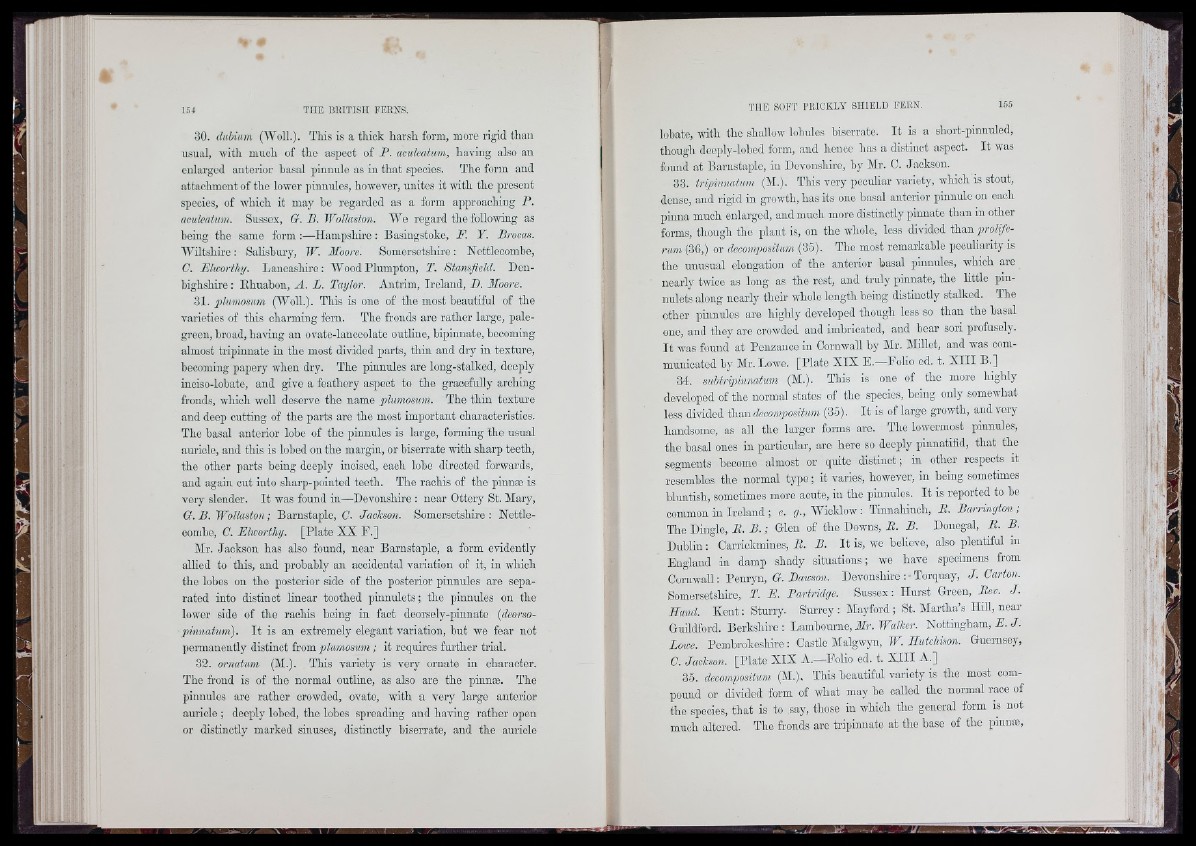
30. diibiitm (IVoll.). This is a thick harsh form, moro rigid than
usual, with much of the aspect of P . aculeatum, having also an
enlarged anterior basal pinnule as in that spooios. The form and
attachment of tho lower piimnlos, however, unites it with the present
spooios, of which it may be regarded as a form approaching P .
aculeatum. Sussex, G. B. Wollaston. IVe regard the following as
being tho samo form :—Hampshire ; Basingstoke, F. Y. Broeas.
lYiltshire ; Salisbury, W. Moore. Somersetshire : Nettleoomhe,
C. Ehcorthy. Lancashire: WoodPlumpton, T. Stansfield. Denbighshire
; Bhuahon, A . L. Taylor. Antrim, Ireland, D. Moore.
31. plumosum (IVoU.). This is one of the most beautiful of the
varieties of this charming forn. Tho fronds are rather largo, pale-
green, broad, having an ovato-lanoeolate outline, bipinnate, becoming
almost tripinnate in tho most divided parts, thin and dry in texture,
hecomiug papery when dry. The pinnules are long-stalked, deeply
inoiso-lobate, and give a feathery aspect to the gracefully arching
fronds, which woll deserve tho name plumosum. The thin texture
and deep cutting of the parts aro tho most important characteristics.
Tho basal anterior lobe of tho pinnules is large, forming the usual
auricle, and this is lobed on the margin, or biserrate with sharp teeth,
the other parts boing deeply incised, each lobe directed forwards,
and again out into sharp-pointed teeth. The raohis of the pinnæ is
very slender. I t was found in—Devonshire : near Ottory St. Mary,
O .B . Wollaston; Barnstaple, C. Jackson. Somersetshire: Nettle-
combo, C. Ehcorthy. [Plate XX P .]
Mr. Jackson has also found, near Barnstaple, a form evidently
allied to this, and probably an accidental variation of it, in which
the lobes on tho posterior side of the posterior pinnules are separated
into distinct linear toothed pinnulets ; the pinnules on the
lower side of the rachis boing in fact deorsely-pinnato (deorso-
pimiatum). I t is an extremely elegant variation, but we fear not
permanently distmot from plumosum ; it requires further trial.
32. oriiatum (M.). This variety is very oruate in character.
The frond is of the normal outline, as also are the pinnæ. The
pinnules are rather crowded, ovate, with a very large anterior
auricle ; deeply lobed, the lobes spreading and having rather open
or distinctly marked sinuses, distinctly biserrate, and the auricle
lohate, with the shallow lohules biserrate. I t is a short-pinnuled,
though dccply-lobcd form, and honco has a distinct aspect. I t was
found at Barnstaple, in Devonshire, hy Mr. C. J aokson.
33. tripinnatum (M.). T h i s very peculiar variety, ivhich is stout,
dense, and rigid in growth, has its ono basal anterior pinnule on each
pinna much enlarged, and much more distinctly pinnate than in other
forms, though tho plant is, on the whole, less divided than ^iro/i/e-
rum (30,) or decompositum (35). The most remarkable peculiarity is
the unusual elongation of the anterior basal piiinulos, which are
nearly twice as long as tho rest, and truly pinnate, tho little pin-
nulcts along nearly thoir whole length boing distinctly stalked. The
other pinnules are highly developed though less so than the basal
ono, and they are crowded and imbricated, and bear sori profusely.
I t was found at Penzance in Cornwall by Mr. Millet, and was communicated
by Mr. Lowe. [Plato X IX E .—Eolio cd. t. X I I I B.]
34. subtripinriatim (M.). This is one of tho moro highly
developed of tho normal states of the species, hoing only somewhat
less divided than decompositum (35). I t is of large growth, and very
handsome, as all the larger forms aro. The lowermost pinnules,
tho basal ones in particular, aro hero so deeply pinnatifid, th a t the
segments become almost or quite distinct; in other respects it
resembles the normal ty p o ; it varies, however, in being sometimes
bluntish, sometimes more acute, in the pinnules. I t is reported to be
common in Ireland ; c. g., IVicldow : Tinnahinoh, B . Barrington;
The Dingle, B . B .; Glon of tho Downs, B . B. Donegal, R. B.
Dublin : Carrickmincs, B. B. I t is, we believe, also plentiful iii
England in damp shady situations; we have specimens from
Cornwall: Penryn, G. Daicson. Devonshire : Torquay, J . Carton.
Somursetshiro, T. E . Partridge. Sussex: Hurst Green, Rev. J .
Hand. K e n t: Sturry. Surrey : Mayford ; St. Martha’s Hill, near
Guildford. Berkshire : Lambourne, Mr. Walker. Nottingham, P. J.
Lowe. Pomhrokoshiro : Castle Malgwyn, W. Hutchison. Guernsey,
C. Jackson. [Plate XIX A.—Eolio ed. t. X I I I A.]
35. decompositum (M.), This beautiful variety is tho most compound
or diridcd form of what may he called tho normal race of
the species, that is to say, those in which tho general form is not
much altered. Tho fronds are tripinnate at the base of tho pinnfB,